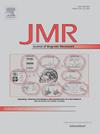Stability of the polarization agent AsymPolPOK in intact and lysed mammalian cells
IF 1.9
3区 化学
Q3 BIOCHEMICAL RESEARCH METHODS
引用次数: 0
Abstract
Dynamic nuclear polarization (DNP) solid-state NMR enables detection of proteins inside cells through sensitivity enhancement from nitroxide biradical polarization agents. AsymPolPOK, a novel water-soluble asymmetric nitroxide biradical, offers superior sensitivity and faster build-up times compared to existing agents like AMUPol. Here, we characterize AsymPolPOK's behavior in mammalian HEK293 cells, examining its cellular distribution, reduction kinetics, and DNP performance. We demonstrate that electroporation achieves uniform cellular delivery of AsymPolPOK, including nuclear permeation, with no cytotoxicity at millimolar concentrations. However, the cellular environment rapidly reduces AsymPolPOK to its monoradical form, with one nitroxide center showing greater reduction resistance than the other. While AsymPolPOK maintains high DNP enhancements and short build-up times in lysates, its performance in intact cells depends critically on delivery method and exposure time to cellular constituents. Electroporation yields higher, more uniform enhancements compared to incubation, but prolonged exposure to the cellular environment diminishes DNP performance in both cases. These findings establish AsymPolPOK's potential for in-cell DNP NMR while highlighting the need for developing more bio-resistant polarization agents to further advance cellular structural biology studies.

极化剂AsymPolPOK在完整和裂解的哺乳动物细胞中的稳定性
动态核极化(DNP)固态核磁共振通过提高氮氧基极化剂的灵敏度来检测细胞内的蛋白质。AsymPolPOK是一种新型的水溶性不对称氮氧化物双自由基,与AMUPol等现有试剂相比,具有更高的灵敏度和更快的积累时间。在这里,我们表征了AsymPolPOK在哺乳动物HEK293细胞中的行为,检查了它的细胞分布、还原动力学和DNP性能。我们证明了电穿孔实现了AsymPolPOK的均匀细胞递送,包括核渗透,在毫摩尔浓度下没有细胞毒性。然而,细胞环境迅速将AsymPolPOK还原为单根形式,其中一个氮氧化物中心表现出比另一个更大的还原阻力。虽然AsymPolPOK在裂解物中保持高DNP增强和短构建时间,但其在完整细胞中的性能主要取决于递送方法和细胞成分暴露时间。与孵育相比,电穿孔产生更高、更均匀的增强,但在两种情况下,长时间暴露于细胞环境会降低DNP的性能。这些发现确立了AsymPolPOK在细胞内DNP NMR中的潜力,同时强调了开发更多生物抗性极化剂以进一步推进细胞结构生物学研究的必要性。
本文章由计算机程序翻译,如有差异,请以英文原文为准。
求助全文
约1分钟内获得全文
求助全文
来源期刊
CiteScore
3.80
自引率
13.60%
发文量
150
审稿时长
69 days
期刊介绍:
The Journal of Magnetic Resonance presents original technical and scientific papers in all aspects of magnetic resonance, including nuclear magnetic resonance spectroscopy (NMR) of solids and liquids, electron spin/paramagnetic resonance (EPR), in vivo magnetic resonance imaging (MRI) and spectroscopy (MRS), nuclear quadrupole resonance (NQR) and magnetic resonance phenomena at nearly zero fields or in combination with optics. The Journal''s main aims include deepening the physical principles underlying all these spectroscopies, publishing significant theoretical and experimental results leading to spectral and spatial progress in these areas, and opening new MR-based applications in chemistry, biology and medicine. The Journal also seeks descriptions of novel apparatuses, new experimental protocols, and new procedures of data analysis and interpretation - including computational and quantum-mechanical methods - capable of advancing MR spectroscopy and imaging.

 求助内容:
求助内容: 应助结果提醒方式:
应助结果提醒方式:


